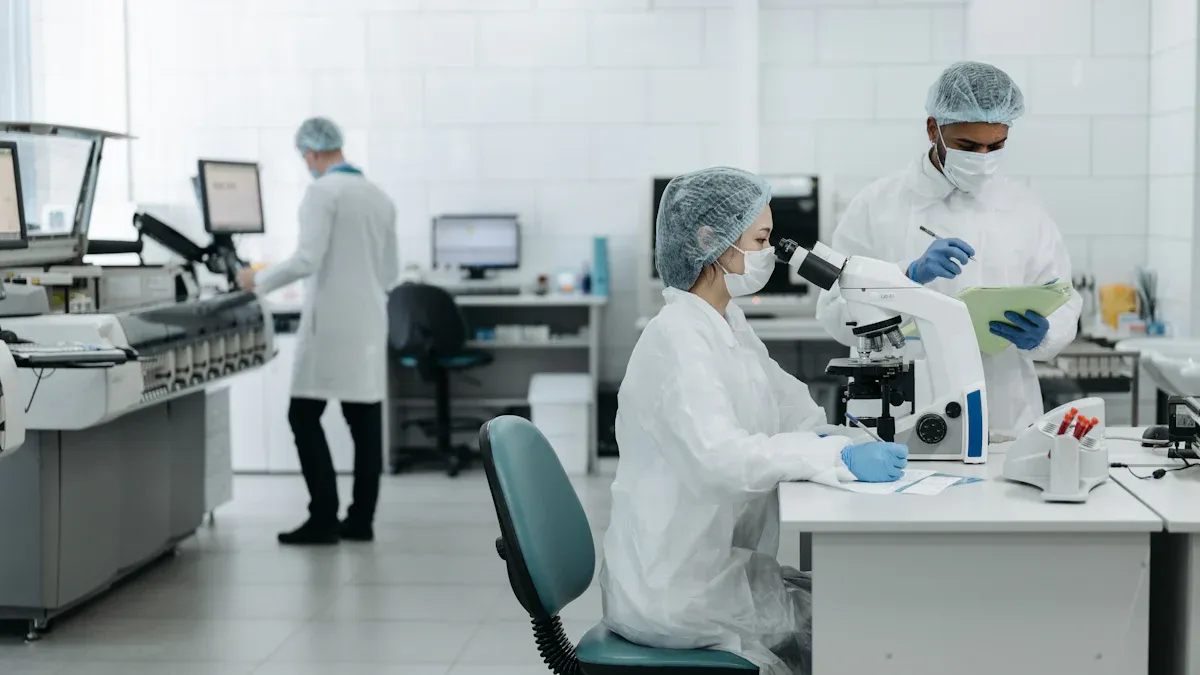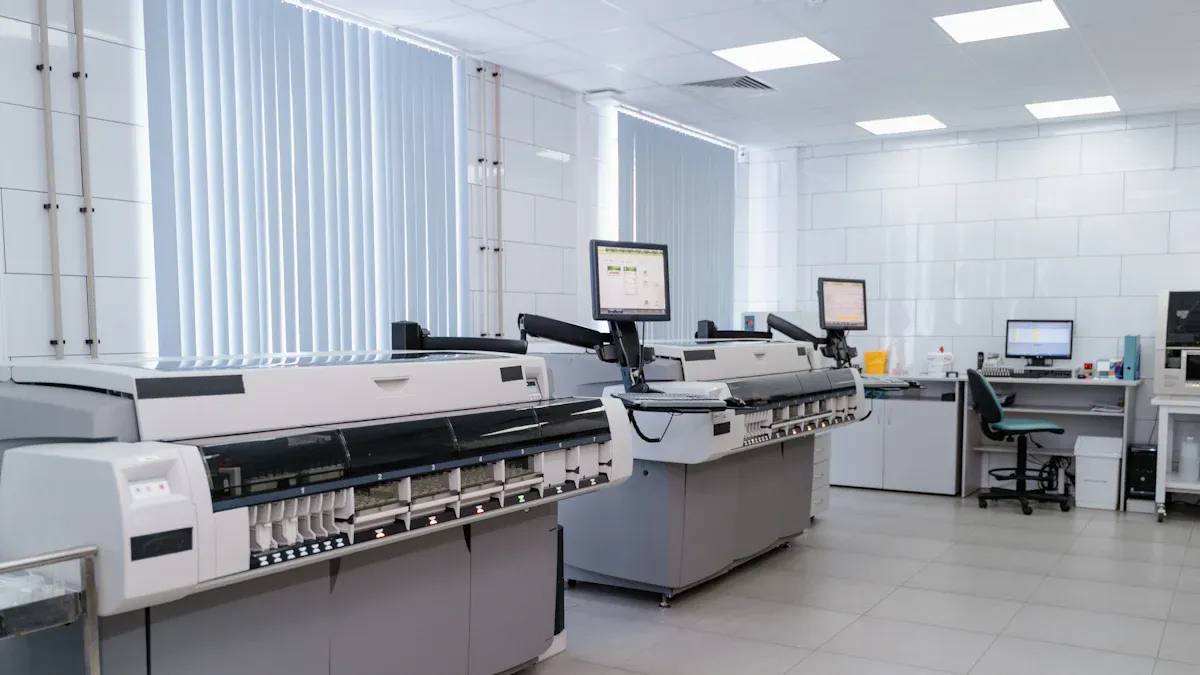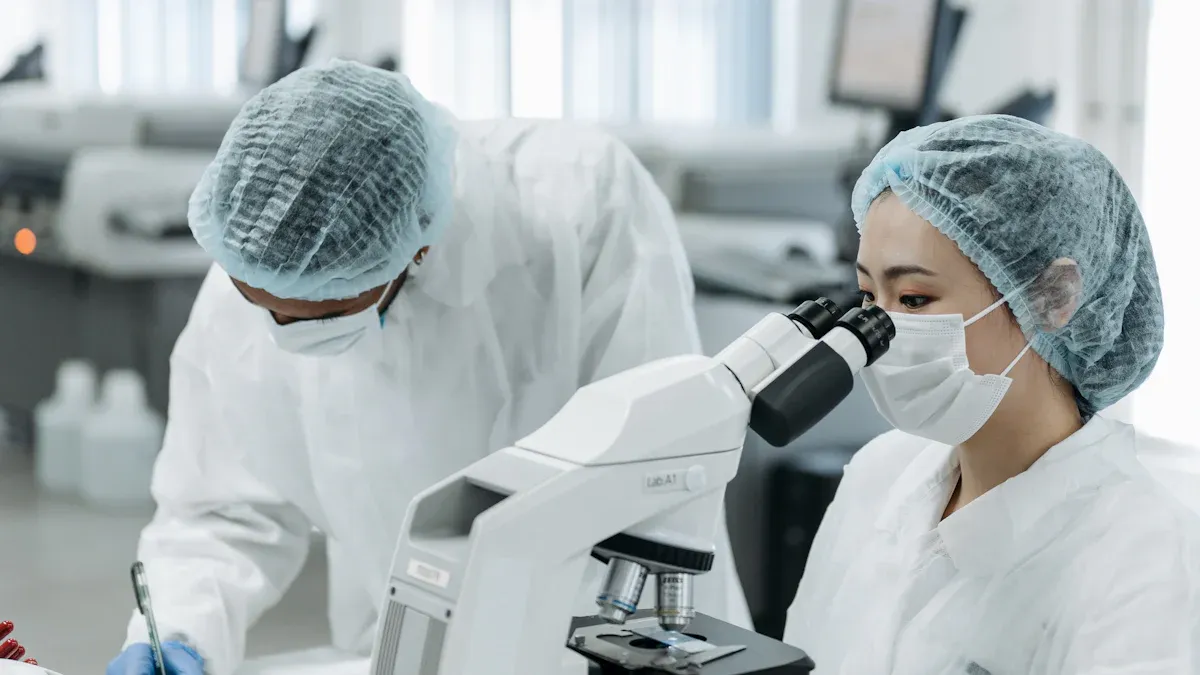Medical PCBA Manufacturing Outsourcing Key Pros and Cons to Consider

More than half of medical device companies now opt for outsourcing in PCBA medical manufacturing, motivated by the pursuit of cost efficiency, specialized expertise, and faster market response. When considering PCBA medical solutions, companies evaluate the advantages and disadvantages of outsourcing versus in-house production. Outsourcing PCBA medical services can provide access to advanced technology and greater supply chain flexibility, while also requiring careful management of supplier relationships and quality assurance. Decision-makers in the PCBA medical field must weigh these factors to determine whether in-house or external manufacturing best aligns with their strategic objectives.
Key Takeaways
Outsourcing medical PCBA manufacturing can save costs by reducing labor and inventory expenses while improving efficiency and product quality.
Partnering with specialized manufacturers gives access to advanced technology and expert processes that meet strict medical standards.
Outsourcing offers flexibility to quickly scale production up or down, helping companies respond to market changes without large fixed costs.
Strong communication, clear contracts, and quality controls are essential to protect intellectual property and maintain oversight when outsourcing.
Careful evaluation of internal capabilities, cost analysis, and partner selection helps companies decide if outsourcing fits their strategic goals.
Pros and Cons of Outsourcing

Cost and Efficiency
Medical device companies often choose outsourcing pcb assembly to reduce manufacturing costs and improve efficiency. Industry analysis shows that outsourcing pcba medical production to EMS providers leads to average cost savings of 10–15% compared to maintaining equivalent in-house capabilities. These savings come from lower labor expenses, reduced overhead, and access to economies of scale in component purchasing. Contract manufacturers streamline procurement, logistics, and inventory management, allowing companies to maintain low inventory levels and minimize waste.
Outsourcing transforms long lead time challenges into competitive advantages. Companies benefit from lean replenishment, reduced labor, and lower inventory costs, while also improving product quality and reliability. For example, a medical device OEM that outsourced PCB assembly reported shorter turnaround times and fewer production delays, enabling faster market entry for new products.
Expertise and Technology
Outsourcing gives medical device companies access to advanced manufacturing technologies and specialized expertise that may not be available in-house. Leading PCBA manufacturers offer integrated fabrication and assembly, rigorous quality control, and in-house engineering support. They use automated optical inspection (AOI), BGA X-ray, and flying probe tests to ensure high reliability and compliance with medical-grade standards.
Specialized Expertise & Technologies | Compliance & Standards | Unique Capabilities for Medical Devices | |
|---|---|---|---|
Eltek | High-reliability PCB manufacturing for critical life support and implantable devices; rigid, HDI, flexible boards; dust-free environment; customized circuit solutions | ISO 13485, FDA, European medical regulations | Mission-critical devices like cardiac pacemakers, nerve stimulators, implantable sensors |
Cicor Group | Miniaturized circuit design; aseptic and cleanroom production; ceramic, FPC, rigid-flex boards, thin-film sensors; advanced packaging | MDR, FDA, ISO 13485 | Integrated design and mass production for implantable, diagnostic, wearable devices |
Flex Ltd. | Complete R&D, prototyping, SMT assembly, testing, packaging; smart wearables, remote monitoring, diagnostic devices | FDA registration, ISO 13485, ISO 14971 | Supports rapid market launch and global deployment; end-to-end medical device manufacturing |
General Trends | Miniaturization, flexible circuits, low-power designs; wireless communication modules; high-speed signal processing; biocompatible materials and coatings | N/A | HDI and rigid-flex boards for complex shapes; implantable and wearable device support |
The expertise of specialised vendors ensures that medical device companies can leverage the latest innovations in pcb design and manufacturing. Outsourcing pcb assembly also allows companies to focus on core competencies such as product development and innovation.
Flexibility and Scalability
Outsourcing provides medical device companies with the flexibility to scale manufacturing volumes up or down in response to market demand. Contract manufacturers enable rapid ramp-up or scale-down of production without incurring fixed costs tied to in-house facilities. This flexibility is crucial in the medical sector, where demand can fluctuate due to new product launches or seasonal changes.
Contract manufacturers offer agile manufacturing environments and automated material requirements planning (MRP) systems.
Real-time electronic data interchange (EDI) supports quick adjustments to material purchase orders.
New Product Introduction (NPI) procedures provide feedback at every stage, ensuring smooth transitions.
Sophisticated document control systems manage multiple revisions and engineering change notes (ECNs).
Turnkey partnerships and long-term strategic outsourcing models formalize scalability, rapid prototyping, and engineering support. These arrangements help companies respond quickly to changing requirements and maintain control over costs and quality.
Control and Communication
Outsourcing introduces challenges related to control and communication. Medical device companies often report concerns about intellectual property protection, loss of visibility into manufacturing processes, and cultural differences that affect problem-solving.
Intellectual property protection requires encrypted data transmission, rigorous user authentication, and ISO 27001 certification from suppliers.
Confidentiality agreements (NDAs), direct control of sensitive components, and strict management of technical documents help safeguard proprietary information.
Communication breakdowns between dispersed partners can increase errors and slow issue resolution.
Managing relationships across different time zones and cultures complicates accountability.
Clear contracts, strong communication, and transparency are essential to manage these risks.
Personal engagement methods such as site visits and virtual meetings foster collaboration and improve communication.
Medical device companies must establish robust quality control processes and clear communication protocols to maintain control over outsourced manufacturing operations.
Quality and Compliance
Quality and compliance remain top priorities in pcba medical manufacturing. Outsourcing to experienced partners ensures adherence to evolving regulatory standards such as FDA, ISO 13485, and EU MDR.
Contract manufacturers maintain FDA compliance and hold ISO certifications, guaranteeing alignment with high-quality standards.
Verification and validation services streamline approval processes and reduce regulatory risks.
Risk management practices identify and mitigate production and compliance risks early in development.
Quality control is upheld through verification and validation testing, reducing defects and recalls.
Common Quality and Compliance Issues | Typical Approaches to Address Them |
|---|---|
Regulatory non-compliance | Partner with ISO 13485 certified and FDA registered manufacturers; maintain up-to-date records and documentation |
Loss of oversight | Conduct thorough supplier evaluations and audits; maintain transparency and communication |
Data integrity and security risks | Use validated digital tools; maintain detailed documentation and audit trails |
Misaligned CAPA integration | Integrate complaint handling tightly with CAPA workflows |
Counterfeit components | Work only with vetted suppliers; carry out detailed design reviews |
Process failures | Implement risk-based approaches such as PFMEA; establish robust quality management systems |
A mid-sized U.S. medical device company improved its complaint handling by outsourcing to a specialized provider. The result was a 30% faster complaint triage-to-closure timeline, a 35% reduction in operational costs, and 100% on-time regulatory submissions. Outsourcing pcb assembly, when combined with strong oversight and compliance controls, effectively addresses common quality and compliance challenges and supports reliable turnaround time.
PCBA Medical Quality Factors

Regulatory Standards
Medical device companies must meet strict regulatory standards in pcba medical manufacturing. ISO 13485 sets the foundation for quality management systems specific to medical devices. This standard aligns closely with FDA 21 CFR Part 820, which governs quality system regulations in the United States. Both frameworks require detailed documentation, traceability, and process validation to ensure product safety and effectiveness.
Regulatory audits often focus on design reviews, risk management, and documentation. Auditors look for evidence of proper equipment maintenance, calibration, and a robust quality control plan.
The table below summarizes key standards relevant to pcba medical manufacturing:
Standard/Regulation | Description |
|---|---|
Quality management for medical devices, emphasizing documentation and control | |
FDA 21 CFR Part 820 | US quality system regulation for medical device manufacturing |
IPC Standards | PCB design and assembly standards, including IPC-A-610 for Class 3 products |
IEC 60601 | Safety and performance for medical electrical equipment |
REACH & RoHS | Environmental and chemical safety compliance |
Risk Management
Effective risk management is essential in pcba medical manufacturing. Companies face risks such as counterfeit components, supply chain disruptions, and regulatory non-compliance.
Partnering with certified manufacturers ensures access to proper equipment and skilled staff.
Process Failure Mode and Effect Analysis (PFMEA) helps identify and address potential failures early.
Maintaining a vetted supply network reduces the risk of counterfeit or obsolete parts.
Traceability throughout the pcb manufacturing process supports transparency and accountability.
Quality control techniques like Automated Optical Inspection (AOI) and X-ray inspection catch defects before products reach the market.
A structured risk management approach, supported by continuous process validation and thorough documentation, helps companies avoid costly recalls and regulatory actions.
LTPCBA’s Quality Assurance
LTPCBA stands out in the pcba medical sector by maintaining a 99.5% pass rate in product delivery. The company holds certifications such as ISO 9001, IATF, UL, and IPC-A-610, meeting or exceeding industry benchmarks for quality assurance.
LTPCBA uses advanced testing methods, including AOI, X-ray, and in-circuit testing, to ensure defect-free pcb assemblies.
The company’s quality control system aligns with ISO 13485 requirements, supporting medical device reliability and safety.
Environmental and functional testing further guarantee that products withstand real-world conditions.
LTPCBA’s commitment to quality, speed, and customer support makes it a trusted partner for medical device manufacturing.
This combination of certifications, rigorous testing, and a high pass rate demonstrates LTPCBA’s dedication to delivering reliable pcba medical solutions.
Outsourcing PCB Assembly with LTPCBA
End-to-End Solutions
LTPCBA delivers comprehensive end-to-end solutions for medical device companies seeking reliable outsourcing pcb assembly. Their turnkey services cover every stage of the manufacturing process, from initial design and engineering to assembly, testing, and shipping. A single project manager oversees each project, simplifying communication and ensuring accountability.
LTPCBA sources all components, manages prototyping, and handles quality control, meeting strict medical standards such as ISO 13485 and FDA regulations.
Real-time project tracking and updates allow early detection of issues, improving resource allocation and project management.
Local USA-based manufacturing reduces lead times, protects intellectual property, and avoids overseas shipping delays.
Fast turnaround and rapid prototyping help medical device companies respond quickly to market demands.
Cost efficiencies result from bulk purchasing, streamlined production, and unified quality control.
This turnkey approach reduces risks and accelerates product launches, making outsourcing pcb assembly with LTPCBA a strategic choice for medical device manufacturers.
Advanced Technology
LTPCBA invests in advanced manufacturing technologies to ensure high-quality pcb assembly. Their facilities use X-ray alignment systems for precise layer registration, CNC and laser drilling for microvias, and automated solder paste application with tight thickness control.
High-speed pick-and-place machines achieve micron-level accuracy, supported by real-time vision correction.
Multiple soldering methods and thermal profiling prevent component damage and ensure reliable joints.
Rigorous inspection includes AOI, X-ray, In-Circuit Testing, and environmental stress tests.
LTPCBA also integrates AI and machine learning for predictive maintenance, reducing downtime and defects. Automation and robotics increase machine uptime and reduce human error. These technologies guarantee consistent quality, short turnaround times, and compliance with medical standards.
Customer Support
LTPCBA provides robust customer support throughout the manufacturing process. Their team offers 24-hour technical assistance, rapid prototyping, and clear project updates.
LTPCBA’s multi-stage testing, including AOI and functional testing, ensures product reliability and safety.
They use secure packaging and traceable labeling to protect products during shipping. Supplier vetting and trusted sourcing guarantee quality and on-time delivery. LTPCBA maintains a 99.5% on-time delivery rate, supporting fast turnaround and reliability.
A dedicated support team responds quickly to inquiries, resolves issues efficiently, and maintains high customer satisfaction. Daily meetings, shared reports, and tracking tools keep projects aligned and transparent, making outsourcing with LTPCBA a dependable solution for medical device companies.
Is Outsourcing Right for You?
Internal Capabilities
Medical device companies should begin by evaluating their in-house pcb assembly capabilities. A thorough assessment includes:
Electromechanical assembly skills that go beyond basic PCB manufacturing, such as integrating electronic components, enclosures, and user interfaces.
Quality and compliance systems, including ISO 13485 and ISO 9001 certifications, to meet medical standards.
FDA-compliant processes with strong risk management, validation, and documentation for regulatory submissions.
Robust process controls and audit readiness to maintain high quality.
Supply chain management with verified suppliers, counterfeit detection, and traceability.
Specialized manufacturing cells tailored to product needs.
Functional and burn-in testing to validate device performance.
Detailed Device Master Records and process validation records for FDA clearance.
ERP systems designed for medical OEMs to manage materials and inventory.
Companies with a specialised skill set and advanced infrastructure may find in-house pcb assembly more suitable, especially when seeking maximum control and direct oversight.
Cost Analysis
A comprehensive cost analysis helps determine if outsourcing or in-house pcb assembly offers better value. Companies should consider:
Direct costs: design, regulatory compliance, materials, labor, and quality assurance.
Indirect costs: project management, intellectual property protection, logistics, and communication.
Hidden costs: quality control, shipping, inventory management, legal issues, and reputation risks.
Cost drivers: device complexity, production volume, location, and timeline urgency.
A detailed cost-benefit analysis should include all direct, indirect, and hidden costs. Failure to account for hidden costs can erode expected savings and impact financial stability.
Partner Selection
Choosing the right outsourcing partner is critical. Companies should look for:
Certified quality management systems, such as ISO 13485 and FDA compliance.
Advanced manufacturing technology, including automated optical inspection and laser drilling.
Comprehensive testing protocols for electrical, functional, and environmental reliability.
Scalability and flexibility to handle changing production volumes.
Transparent cost structures and a focus on long-term value.
Strong supply chain management and contingency planning.
Experience in medical device manufacturing and regulatory documentation.
A reliable partner acts as a business ally, not just a supplier, supporting both operational needs and product goals.
Risk Mitigation
Risk mitigation strategies protect intellectual property and ensure quality during outsourcing. Companies should:
Define production requirements, quality standards, and timelines clearly.
Establish detailed contracts with IP protections and quality control measures.
Select partners with strong reputations for respecting intellectual property.
Use legal protections like patents and NDAs.
Implement information compartmentalization and regular audits.
Maintain robust communication protocols and dedicated account management.
Consider domestic partners for enhanced IP protection and supply chain stability.
Proactive risk management ensures control over sensitive information and product quality, reducing the likelihood of costly disruptions.
Medical device companies face important choices when considering PCBA manufacturing outsourcing. Outsourcing offers cost savings, advanced technology, and flexibility, but it also introduces risks in control and communication. Decision-makers should review their internal capabilities, analyze costs, and select partners carefully.
Use the evaluation checklist to guide your next steps. Consult with your team, gather input from stakeholders, and consider reaching out to a trusted provider like LTPCBA for expert support. For more insights, explore additional resources or schedule a professional consultation.
FAQ
What certifications should a medical PCBA manufacturer have?
A reliable manufacturer holds certifications like ISO 13485, ISO 9001, and UL. These standards ensure quality management, regulatory compliance, and product safety for medical devices.
How does outsourcing affect intellectual property protection?
Outsourcing partners use NDAs, secure data transmission, and strict access controls. Companies should choose partners with a strong reputation for IP protection and transparent security protocols.
What is the typical lead time for outsourced medical PCB assembly?
Lead times vary by project complexity and volume. Most providers deliver prototypes in 5–10 days and production runs in 2–4 weeks. Fast-track services may shorten timelines.
How do manufacturers ensure quality in medical PCBA assembly?
Manufacturers use automated optical inspection, X-ray testing, and in-circuit testing. They follow strict process controls and maintain detailed documentation to meet regulatory standards.
Can outsourcing help with rapid product scaling?
Yes. Outsourcing partners offer flexible production capacity. They can quickly increase or decrease output to match changing market demands or new product launches.
See Also
Ways Contract PCBA Manufacturing Improves Business Productivity
Key PCBA Processing Needs For Medical Device Manufacturing
Sourcing Electronic Parts Essential For PCBA Production
Comprehensive PCBA Manufacturing Process Guide For All Levels
